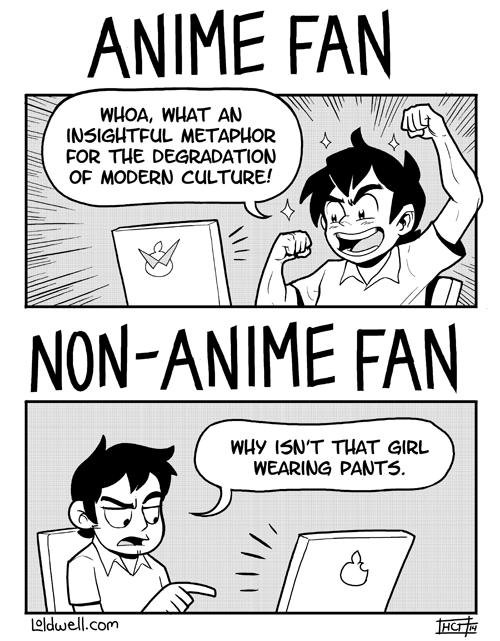Recently a friend of mine became interested in anime. She’d never seen anything but Studio Ghibli movies, so she went to me to ask for suggestions.
“I heard about this show, Kill La Kill, that was supposed to be pretty good,” she said.
“No! Not that! I mean, there’s so much else to watch first,” I stammered.
Kill La Kill is many things, but it is not the anime you show to mom and dad to demonstrate what a well adjusted adult you’ve become. It is not something you want the TSA to find in your carry-on at the airport. And it is certainly not an ideal “gateway” series for my anime-beginner friend.
I’m not saying that Kill La Kill isn’t much more nuanced than it looks on the surface. It’s one of the most important shows of the year for the depth of its message. My friends Charles Dunbar and Katriel Paige made a powerful academic case for Kill La Kill being based on the clash in Japanese 19th century history between eastern Shinto myths and western cultural reform.
And that’s only one interpretation. Earlier this year, I published Grant’s guest post on Kill La Kill and the way our families make us who we are. Later, Mike Rugnetta of the PBS Idea Channel saw it as an ill omen about the future of wearable technology.
It’s a very deep story open to many analyses—but it still centers around two girls who are frequently wearing little to no clothing while cutting peoples’ limbs off.
Loldwell had it right in a comic (top) about the difference between anime fans and outsiders watching the show. You can’t expect people to grasp any other message when a show is utterly and unapologetically sexually and violently explicit on the surface. Intentionally or not, Studio Trigger made a character design decision that severely limits Kill La Kill’s audience.
Kill La Kill blurs the lines between anime that’s designed to make you think and anime that’s meant to turn you on. A new fan asks me about it and I’m twelve again, standing in the local Blockbuster, trying to explain to my parents that anime isn’t porn even though the store groups tentacle sex and Pokémon together in one section labeled “Anime.” Usually when an especially sexual or violent anime comes out, you can tell people to ignore it. But Kill La Kill is too important to ignore. I don’t want to disparage it, but I don’t want it to be anyone’s first impression of what anime is.
I decided to start off my Twelve Days of Anime with Kill La Kill because it is the quintessential 2014 anime, the one we will remember. But not necessarily for purely positive reasons. It brought an adult-content anime into the spotlight, and with it my old feelings of defensiveness when called upon to explain what anime is all about.
This post is the first installment of The Twelve Days Of Anime, a blogging series in which anime fans write about shows that inspired or impressed on them this year. For all the posts in this series, visit my table of contents.
Discover more from Otaku Journalist
Subscribe to get the latest posts sent to your email.





5 Comments.
[…] Dec. 14 — Why Kill La Kill won’t be a gateway show […]
Im seriously wondering how many of these “12 Days” lists will feature Kill la Kill. Mine will, twice.
@charlesdunbar:disqus I didn’t know you were participating! I wish there were a list of everyone who is. Going to read yours now =)
It was a last-minute thing. I feel like I need to share more, as I update too infrequently these days.
[…] La Kill is going to air on Toonami! In a reasonable time slot! I wrote recently that it won’t ever be a gateway anime, but this could prove me wrong. I’m just wondering how much they’ll have to blur to put […]